
| Version | Summary | Created by | Modification | Content Size | Created at | Operation |
|---|---|---|---|---|---|---|
| 1 | Dean Liu | -- | 1482 | 2022-09-28 01:38:52 |
Video Upload Options
Exploration Mission-1 or EM-1 (previously known as Space Launch System 1 or SLS-1) is the uncrewed first planned flight of the Space Launch System and the second flight of the Orion Multi-Purpose Crew Vehicle. The launch is planned for June 2020 from Launch Complex 39B at the Kennedy Space Center. The Orion spacecraft will spend approximately 3 weeks in space, including 6 days in a retrograde orbit around the Moon. It is planned to be followed by Exploration Mission 2 in 2023.
1. Mission Overview
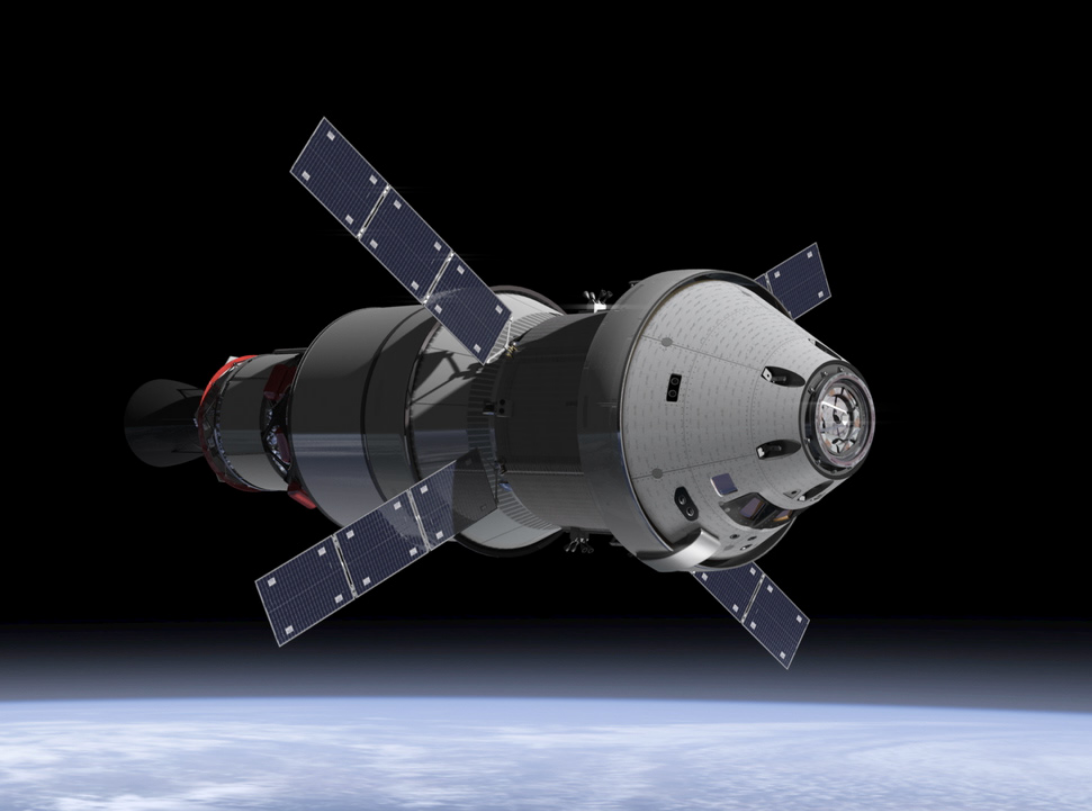
The Block 1 version of SLS used on this mission will consist of two five-segment Solid Rocket Boosters, four RS-25D engines built for the Space Shuttle program and an Interim Cryogenic Propulsion Stage.[1] EM-1 is intended to demonstrate the integrated spacecraft systems prior to a crewed flight, and in addition, test a high speed reentry (11 km/s) on Orion's thermal protection system.[1]
On 16 January 2013, NASA announced that the European Space Agency will build the Orion Service Module based on its Automated Transfer Vehicle, so the flight could also be regarded as a test of ESA hardware as well as American, and of how the ESA components interact with the American Orion components.[2]
The Exploration Flight Test 1 (EFT-1) flight article was consciously constructed in a way that if all the missing components (seats, life support systems) were added, it would not meet the mass target. It was planned that subsequent capsules would be modified to be lighter, based on manufacturing experience.
In January 2015 NASA and Lockheed announced that some components in the EM-1 capsule would be up to 25 percent lighter compared to the previous one. This would be achieved by changes to the primary structure - the EM-1 article would be welded together from 3 panels for the cone, as opposed to 6 panels used for the EFT-1 article. The total number of welds was reduced from 19 to 7,[3] thus saving the additional mass of the weld material. Other savings would be due to revisiting its various components and wiring. For EM-1 the capsule will be outfitted with complete life support system and crew seats, but will be left uncrewed.[4] However, in February 2017 NASA announced that Robert M. Lightfoot Jr., the agency's Acting Administrator, had asked the Human Exploration and Operations Mission Directorate to study the feasibility of redesigning the mission to include a crew.[5]
1.1. Crewed Version
The mission will be uncrewed, however NASA did initiate a study to investigate a crewed version of the mission. A crewed version of EM-1 would be composed of a crew of two astronauts, and will be much shorter than the uncrewed version due to safety reasons. The study investigated a crewed mission even with the possibility of further delays to the launch.[6] On 12 May 2017 NASA revealed that it will not be sending astronauts to space for Orion's EM-1 mission following a months-long feasibility study.[7]
2. History
Originally EM-1 was planned to follow a circumlunar trajectory without entering orbit around the Moon.[1][8]
3. Chronology
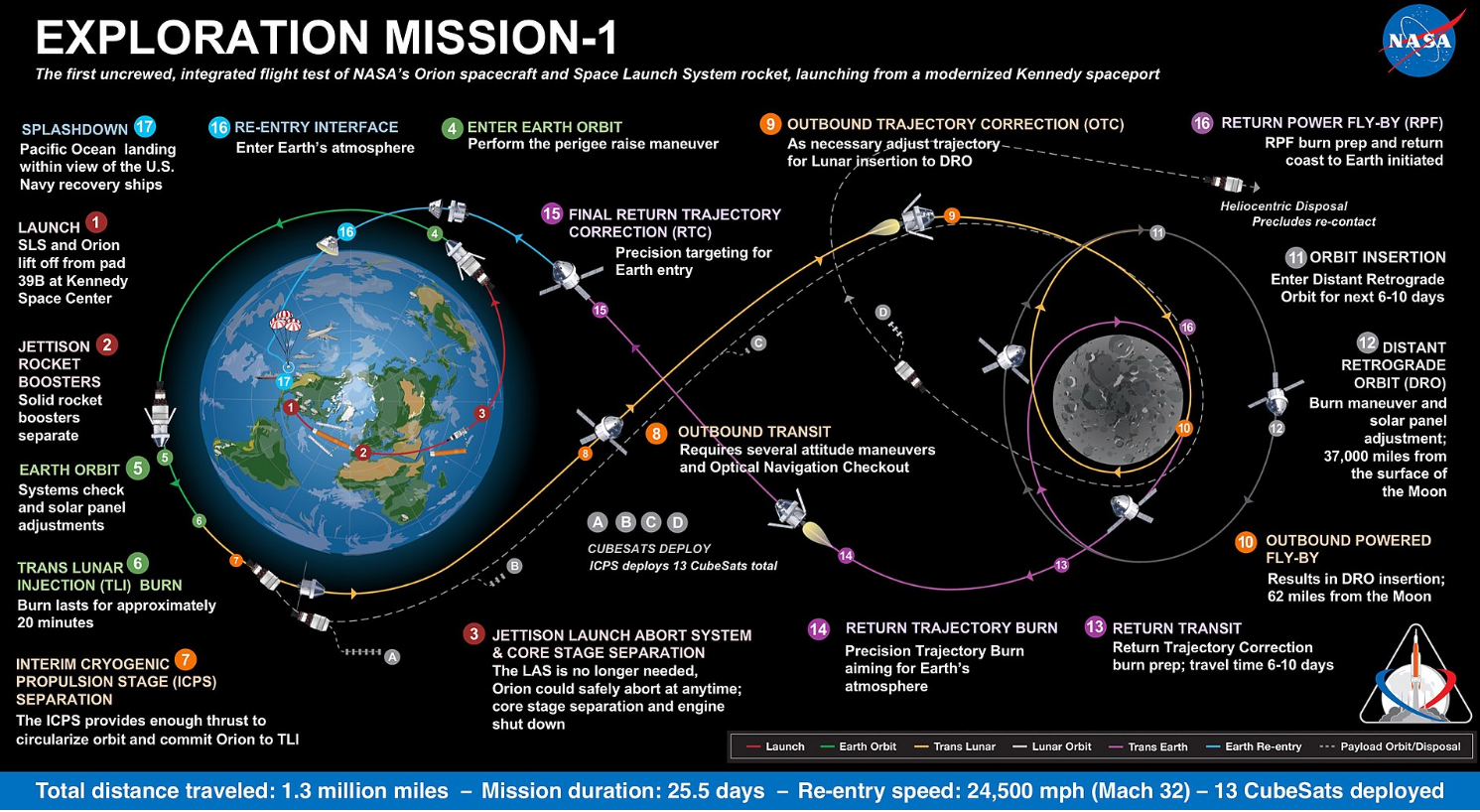
EM-1 will send an uncrewed Orion capsule 1.3 million miles over 25.5 days. It will deploy 13 CubeSats and re-enter at 24,000mph (mach 32). By NASA - https://www.nasa.gov/image-feature/exploration-mission-1-map, Public Domain, https://commons.wikimedia.org/w/index.php?curid=72788861
4. Orion Payloads
NASA has partnered with the German Aerospace Center (DLR) and the Israel Space Agency (ISA) in conjunction with StemRad and Lockheed Martin to perform the Matroshka AstroRad Radiation Experiment (MARE), which will measure tissue dose deposition and test the effectiveness of the AstroRad radiation vest in a radiation environment beyond low Earth orbit. While radiation shielding strategies of the past have relied on storm shelters in which astronauts can seek refuge as solar storms erupt, the AstroRad's ergonomic design provides a mobile protection system with the same shielding factor as storm shelters without hindering the astronauts’ ability to perform mission sensitive tasks.[9]
The crew compartment of the unmanned EM-1 Orion spacecraft will include two female anthropomorphic phantoms which will be exposed to the intense radiation environment along the lunar orbit, including solar storms and galactic cosmic rays. One phantom will be shielded with the AstroRad and the other will be left unprotected. The phantoms provide the opportunity to precisely measure radiation exposure not only at the surface of the body, but also at the exact location of sensitive organs and tissues inside the human body. Radiation exposure will be measured with implementation of both passive and active dosimeters intentionally distributed throughout the inside of the anthropomorphic phantoms at precise locations of sensitive tissues and high stem cell concentrations.[10][11] The results of MARE should enable Orion as a platform for other scientific experiments, provide accurate radiation risk projections of deep space exploration, and validate the protective properties of the AstroRad.
5. Secondary Payloads
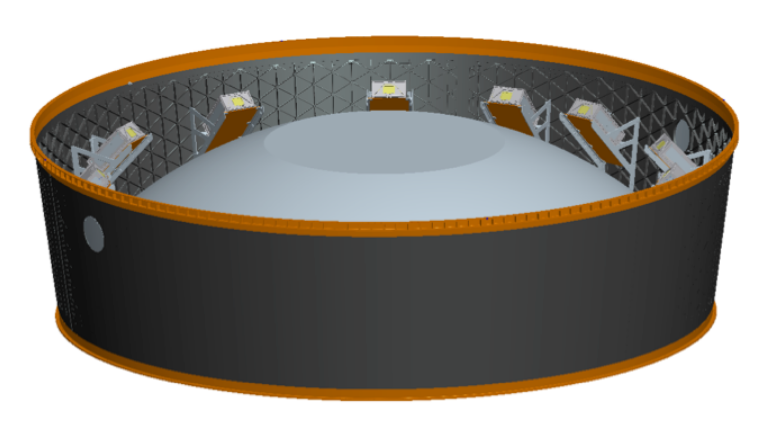
Thirteen low-cost CubeSat missions were competitively selected as secondary payloads on the EM-1 test flight.[12] They will reside within the second stage on the launch vehicle from which they will be deployed. Two CubeSats have been selected through NASA's Next Space Technologies for Exploration Partnership, three through the Human Exploration and Operations Mission Directorate, two through the Science Mission Directorate, and three were chosen from submissions by NASA's international partners. The CubeSat spacecraft selected are:[13][14]
- Lunar Flashlight is a spacecraft that will seek exposed water ice, and map its concentration at the 1-2 kilometer scale within the permanently shadowed regions of the lunar south pole.[15][16]
- Near-Earth Asteroid Scout is proof-of-concept of a controllable CubeSat solar sail spacecraft capable of encountering near-Earth asteroids (NEA).[17] Observations will be achieved through a close (≈10 km) flyby and using a high resolution science-grade monochromatic camera to measure the physical properties of a near-Earth asteroid.[17] A variety of potential targets would be identified based upon launch date, time of flight, and rendezvous velocity.
- BioSentinel is an astrobiology mission that will use yeast to detect, measure, and compare the impact of deep space radiation on living organisms over long durations beyond low-Earth orbit.[14]
- SkyFire is a spacecraft designed by Lockheed Martin to fly by the Moon and collect surface spectroscopy and thermography.
- Lunar IceCube, designed at the Morehead State University, will search for additional evidence of lunar water ice from a low lunar orbit.
- CubeSat for Solar Particles (CuSP), designed at the Southwest Research Institute will study the dynamic particles and magnetic fields that stream from the Sun[18] and as a proof of concept for the feasibility of a network of stations to track space weather.
- Lunar Polar Hydrogen Mapper (LunaH-Map), designed at the Arizona State University,[19] will map hydrogen within craters near the lunar south pole, tracking depth and distribution of hydrogen-rich compounds like water. It will use a neutron detector to measure the energies of neutrons that interacted with material in the lunar surface. Its mission is planned to last 60 days and perform 141 orbits of the Moon.[20]
- EQUULEUS, designed by JAXA and the University of Tokyo, will image Earth's plasmasphere to study the radiation environment around the Earth while demonstrating low thrust maneuvers for trajectory control in the space between Earth and the Moon.[21]
- OMOTENASHI, designed by JAXA, is a lander/impact probe to study the lunar radiation environment.[21][22]
- ArgoMoon, designed by Argotec and coordinated by ASI, is designed to image the Interim Cryogenic Propulsion Stage (ICPS) of Orion for mission data and historical records. It will demonstrate technologies necessary for a small spacecraft to maneuver and operate near the ICPS.[21]
The remaining three slots were selected through a competition pitting CubeSat teams from the United States against each other in a series of ground tournaments called 'NASA's Cube Quest Challenge',[23][24] and were announced by NASA Ames on 8 June 2017. The competition was to contribute to opening deep-space exploration to non-government spacecraft. These slots were awarded to:[25]
- Cislunar Explorers will demonstrate the viability of water electrolysis propulsion and interplanetary optical navigation to orbit the Moon. It was designed by Cornell University, Ithaca, New York.
- Earth Escape Explorer (CU-E3) will demonstrate long-distance communications while in heliocentric orbit. It was designed by the University of Colorado in Boulder.
- Team Miles will demonstrate long-distance communications while in heliocentric orbit and show low-thrust trajectory control techniques by employing a hybrid ion thruster. It was designed by Fluid and Reason, LLC, Tampa, Florida.
6. Gallery
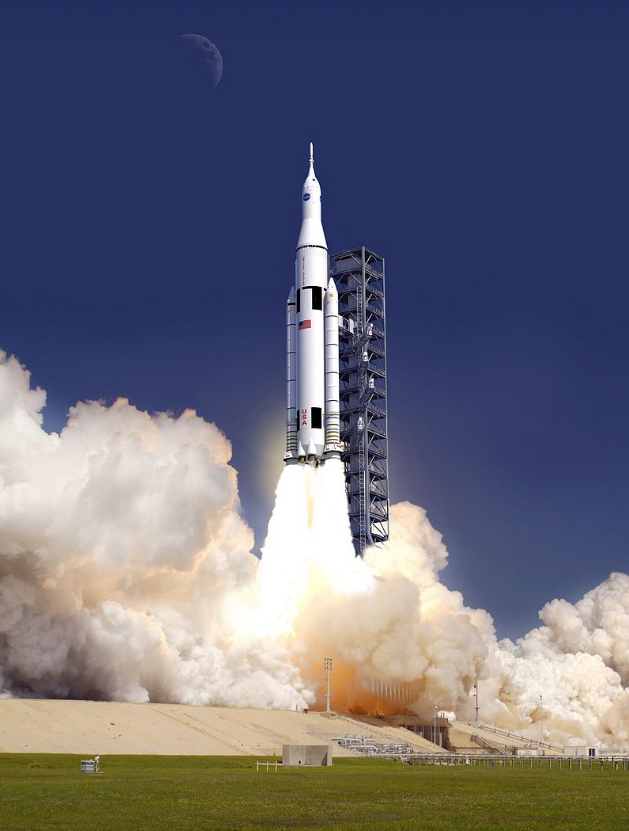
Artist's rendering of the launch of EM-1. By NASA - http://www.nasa.gov/exploration/systems/sls/sls1.html direct link to the picture: http://www.nasa.gov/images/content/588053main_Block_1_launching_high.jpg, Public Domain, https://commons.wikimedia.org/w/index.php?curid=16491826
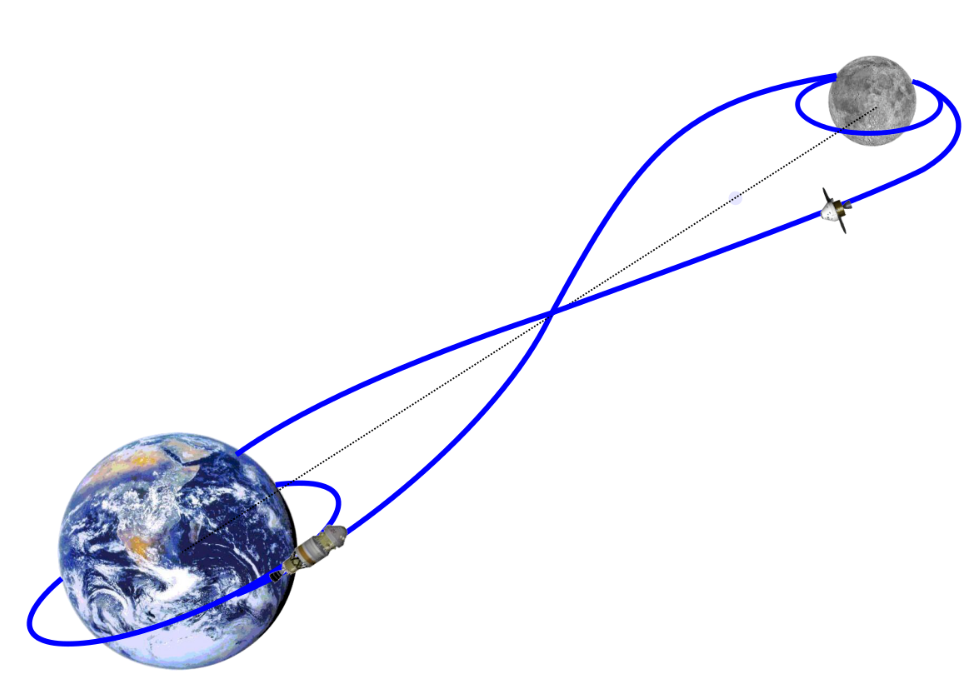
EM-1's orbital path. By NASA - http://www.nasa.gov/pdf/631631main_12-03_HEOC.pdf, Public Domain, https://commons.wikimedia.org/w/index.php?curid=29548747
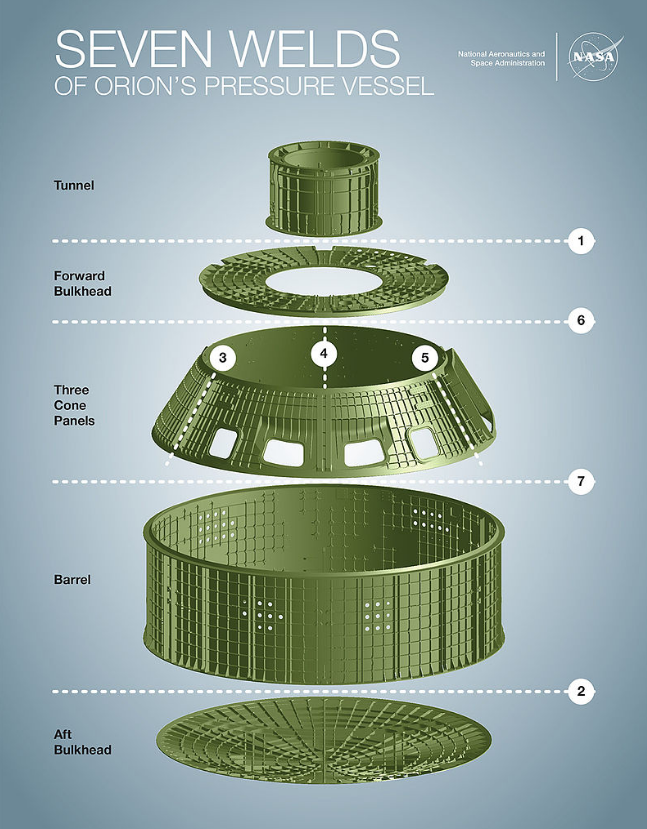
EM-1 Welding sequence. By NASA - http://www.nasa.gov/press-release/first-pieces-of-nasa-s-orion-for-next-mission-come-together-at-michoud, Public Domain, https://commons.wikimedia.org/w/index.php?curid=43026719
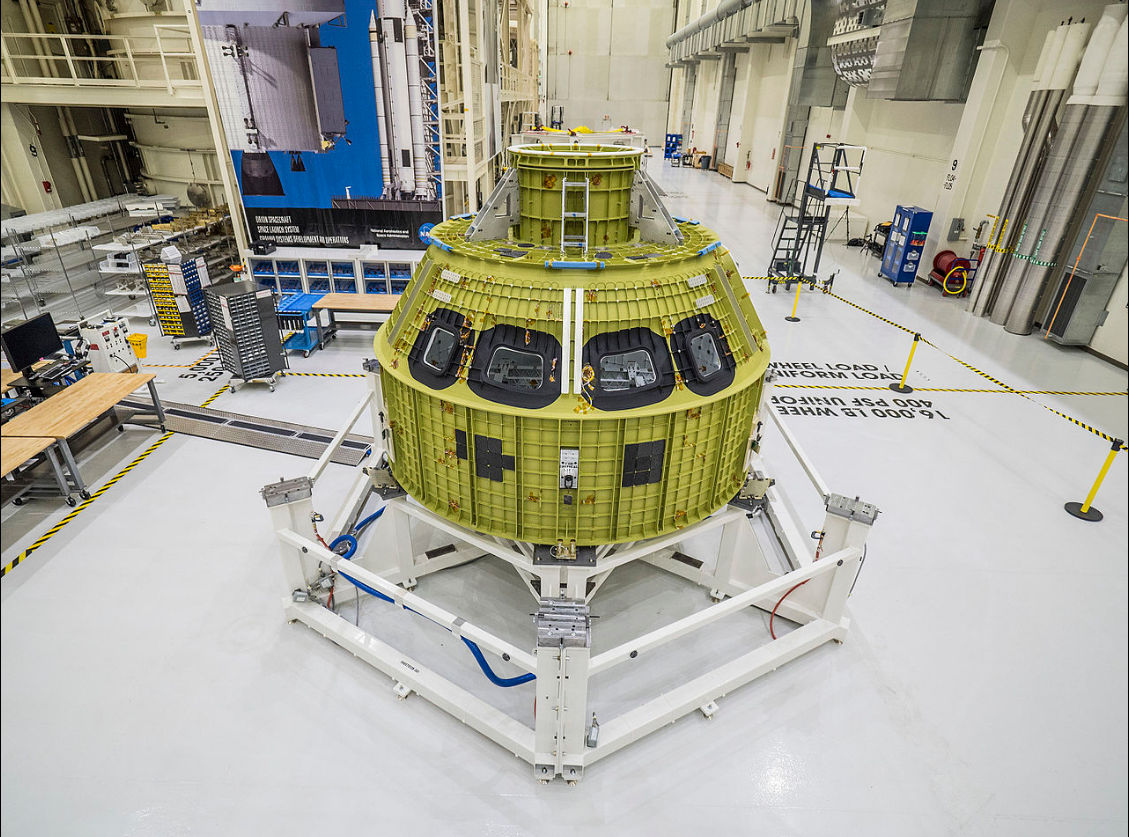
Completed EM-1 Orion weld structure. By Mark Garcia - National Aeronautics and Space Administration, Public Domain, https://commons.wikimedia.org/w/index.php?curid=47740319
References
- Singer, Jody (25 April 2012). "Status of NASA's Space Launch System". NASA Marshall Space Flight Center. http://spirit.as.utexas.edu/~fiso/telecon/Singer_4-25-12/Singer_4-25-12.pdf. Retrieved 5 August 2012.
- "Engineers resolve Orion will 'lose weight' in 2015". NASA. 16 January 2013. http://www.nasa.gov/exploration/systems/mpcv/orion_feature_011613.html. Retrieved 22 March 2013.
- Barrett, Josh (13 January 2015). "Orion program manager talks EFT-1 in Huntsville". Space Alabama (WAAY). Archived from the original on 18 January 2015. https://archive.is/YKKUw.
- "Engineers resolve Orion will 'lose weight' in 2015". WAFF. 13 January 2015. http://www.waff.com/story/27841631/engineers-resolve-orion-will-lose-weight-in-2015. Retrieved 15 January 2015.
- Dunbar, Brian, ed (15 February 2017). "NASA to Study Adding Crew to First Flight of SLS and Orion". NASA. https://www.nasa.gov/feature/nasa-to-study-adding-crew-to-first-flight-of-sls-and-orion. Retrieved 15 February 2017.
- Warner, Cheryl (24 February 2017). "NASA Kicks Off Study to Add Crew to First Flight of Orion, SLS". NASA. https://www.nasa.gov/feature/nasa-kicks-off-study-to-add-crew-to-first-flight-of-orion-sls-as-progress-continues-to-send. Retrieved 27 February 2017.
- Gebhardt, Chris (12 May 2017). "NASA will not put a crew on EM-1, cites cost – not safety – as main reason". NASASpaceFlight.com. https://www.nasaspaceflight.com/2017/05/nasa-em-1-uncrewed-costs-main-reason/.
- Hill, Bill (March 2012). "Exploration Systems Development Status". NASA. http://www.nasa.gov/pdf/630149main_5-Hill_SLS%20MPCV%20GSDO_508.pdf. Retrieved 21 July 2012.
- Pasztor, Andy (17 April 2018). "U.S., Israeli Space Agencies Join Forces to Protect Astronauts From Radiation" (in en-US). Wall Street Journal. ISSN 0099-9660. https://www.wsj.com/articles/u-s-israeli-space-agencies-join-forces-to-protect-astronauts-from-radiation-1523969713.
- Berger, Thomas (2017). "Exploration Missions and Radiation". International Symposium for Personal and Commercial Spaceflight. 11-12 October 2017. Las Cruces, New Mexico.. https://ispcs.com/wp-content/uploads/Thomas-Berger-ISPCS-2017-FINAL-1.compressed.pdf.
- Berger, Thomas (2017). "ISPCS 2017 - Thomas Berger 'Exploration Missions and Radiation'". YouTube.com. International Symposium for Personal and Commercial Spaceflight. https://www.youtube.com/watch?v=l25-4XhcneY&t=634s.
- Healy, Angel (4 February 2016). "Boeing-Built Rocket to Carry Lockheed Martin's Skyfire CubeSat". GovConWire. http://www.govconwire.com/2016/02/boeing-built-rocket-to-carry-lockheed-martins-skyfire-cubesat/. Retrieved 5 February 2016.
- Hambleton, Kathryn; Newton, Kim; Ridinger, Shannon (2 February 2016). "NASA Space Launch System's First Flight to Send Small Sci-Tech Satellites into Space". NASA. https://www.nasa.gov/press-release/nasa-space-launch-system-s-first-flight-to-send-small-sci-tech-satellites-into-space. Retrieved 3 February 2016.
- Zolfagharifard, Ellie (3 April 2015). "An asteroid hunter, lunar flashlight and DNA kit: Nasa reveals experiments its mega rocket will carry on its first test flight". Daily Mail (London). http://www.dailymail.co.uk/sciencetech/article-3025131/An-asteroid-hunter-lunar-flashlight-DNA-kit-Nasa-reveals-experiments-mega-rocket-carry-test-flight.html. Retrieved 24 May 2015.
- "Lunar Flashlight". Solar System Exploration Research Virtual Institute. NASA. 2015. http://sservi.nasa.gov/articles/lunar-flashlight/. Retrieved 23 May 2015.
- Wall, Mike (9 October 2014). "NASA Is Studying How to Mine the Moon for Water". Space.com. http://www.space.com/27388-nasa-moon-mining-missions-water.html. Retrieved 23 May 2015.
- McNutt, Leslie; Johnson, Les; Clardy, Dennon; Castillo-Rogez, Julie; Frick, Andreas; Jones, Laura (2014). "Near-Earth Asteroid Scout". AIAA Space 2014 Conference. 4-7 August 2014. San Diego, California.. American Institute of Aeronautics and Astronautics. M14-3850. https://ntrs.nasa.gov/archive/nasa/casi.ntrs.nasa.gov/20140012882.pdf.
- Frazier, Sarah (2 February 2016). "Heliophysics CubeSat to Launch on NASAs SLS". NASA. http://www.nasa.gov/feature/goddard/2016/heliophysics-cubesat-to-launch-on-nasa-s-sls. Retrieved 5 February 2016.
- LunaH-Map - Homepage at the Arizona State University. http://lunahmap.asu.edu/
- Harbaugh, Jennifer, ed (2 February 2016). "LunaH-Map: University-Built CubeSat to Map Water-Ice on the Moon". NASA. http://www.nasa.gov/feature/lunah-map-university-built-cubesat-to-map-water-ice-on-the-moon. Retrieved 10 February 2016.
- Hambleton, Kathryn; Henry, Kim; McMahan, Tracy (26 May 2016). "International Partners Provide CubeSats for SLS Maiden Flight". NASA. https://www.nasa.gov/exploration/systems/sls/international-partners-provide-cubesats-for-sls-maiden-flight. Retrieved 15 February 2017.
- Hernando-Ayuso, Javier; Ozawa, Yusuke; Takahashi, Shota; Campagnola, Stefano; Ikenaga, Toshinori; Yamaguchi, Tomohiro; Hashimoto, Tatsuaki; Yam, Chit Hong et al. (2017). "Trajectory Design for the JAXA Moon Nano-Lander OMOTENASHI". 31st Annual AIAA/USU Conference on Small Satellites. 5–10 August 2017. Logan, Utah.. SSC17-III-07. https://digitalcommons.usu.edu/cgi/viewcontent.cgi?article=3615&context=smallsat.
- Clark, Stephen (8 April 2015). "NASA adding to list of CubeSats flying on first SLS mission". Spaceflight Now. http://spaceflightnow.com/2015/04/08/nasa-adding-to-list-of-cubesats-flying-on-first-sls-mission/. Retrieved 25 May 2015.
- Steitz, David E. (24 November 2014). "NASA Opens Cube Quest Challenge for Largest-Ever Prize of $5 Million". NASA. http://www.nasa.gov/press/2014/november/nasa-opens-cube-quest-challenge-for-largest-ever-prize-of-5-million-0/. Retrieved 27 May 2015.
- Anderson, Gina; Porter, Molly (8 June 2017). "Three DIY CubeSats Score Rides on NASA's First Flight of Orion, Space Launch System". NASA. https://www.nasa.gov/press-release/three-diy-cubesats-score-rides-on-nasa-s-first-flight-of-orion-space-launch-system.




